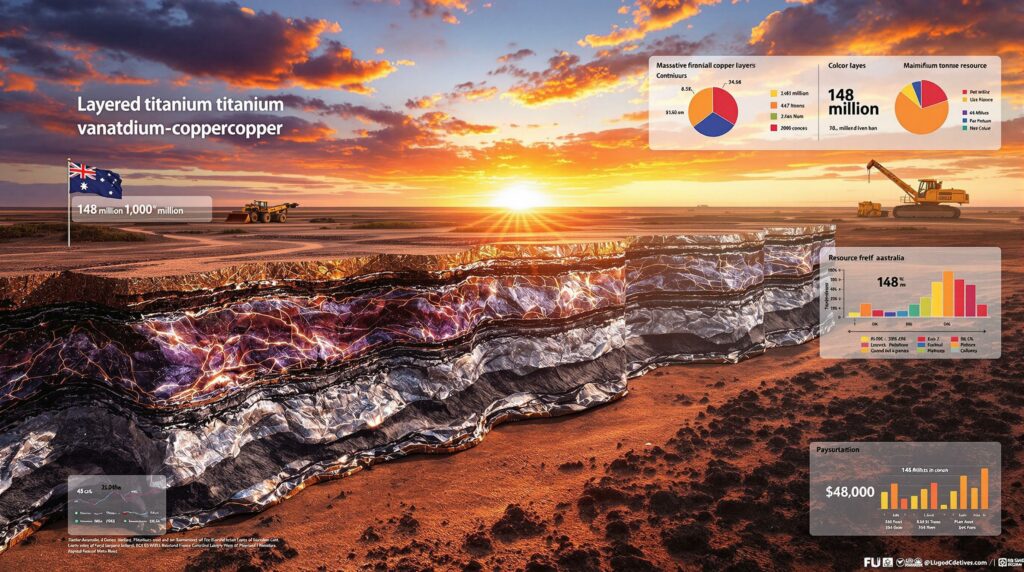What is Terra Metals' Dante Resource and Why Does it Matter?
The mining sector has a new critical minerals story unfolding in Western Australia, where Terra Metals Ltd (ASX:TM1, OTC:PNGZF) has unveiled a remarkable polymetallic discovery. The Dante Project in the West Musgrave region represents a significant titanium-vanadium-copper-platinum group element (PGE) system that has progressed from initial discovery to maiden resource in just 12 months – an unusually rapid timeline in the mining industry.
Understanding the Dante Discovery
The Dante Project sits within the geologically significant Jameson Layered Intrusion, which forms part of the broader Giles Intrusive Complex. What makes this discovery particularly noteworthy is both its size and the diversity of critical minerals energy transition contained within a single geological system.
"Our maiden mineral resource confirms Dante as a globally significant critical metals discovery — and to achieve it within just 12 months, at a very low discovery cost per tonne of resource, is an exceptional result," stated Thomas Line, Managing Director and CEO of Terra Metals.
The resource definition was supported by more than 17,000 metres of reverse circulation and diamond drilling, with the estimate prepared by respected consultants Pivot Mining Consultants.
Resource Size and Grade Breakdown
Total Resource Metrics
The maiden resource at Dante totals 148 million tonnes with impressive grades across multiple metals:
- 14.8% titanium dioxide (TiO₂)
- 0.54% vanadium pentoxide (V₂O₅)
- 0.18% copper (Cu)
- 0.33 g/t 3PGE (platinum, palladium, and gold)
When converted to a copper equivalent grade for comparison purposes, this equates to 1.38% CuEq – a substantial figure for a large-scale deposit. The contained metals represent significant potential value:
- 22 million tonnes of TiO₂
- 800,000 tonnes of V₂O₅
- 270,000 tonnes of copper
- 1.6 million ounces of 3PGE
High-Grade Indicated Resource
Within the broader resource, Terra Metals has defined a high-grade indicated component comprising 38 million tonnes with even more impressive grades:
- 18.4% TiO₂
- 0.73% V₂O₅
- 0.23% Cu
- 0.72 g/t 3PGE (1.87% CuEq)
This high-grade zone contains:
- 7 million tonnes TiO₂
- 280,000 tonnes V₂O₅
- 90,000 tonnes Cu
- 870,000 ounces 3PGE
Industry Perspective: The presence of a substantial high-grade component within a larger resource is particularly valuable for mining projects, as it can potentially provide higher-margin material during early production years, improving project economics and reducing payback periods.
How Does Dante Compare to Global Critical Metal Deposits?
Geological Context and Significance
The Dante Project's geological setting is particularly significant when considering its global context. Located within the Jameson Layered Intrusion, part of the Giles Intrusive Complex, the deposit shares geological similarities with South Africa's renowned Bushveld Complex – home to some of the world's largest PGE and vanadium-titanomagnetite deposits.
This geological similarity provides important context for understanding the potential scale and importance of Terra Metals' discovery. Layered mafic-ultramafic intrusions like these are known to host some of the world's most significant resources of polymetallic nodules insight.
Resource Footprint and Expansion Potential
One of the most compelling aspects of the Dante discovery is its expansion potential. The current resource estimate covers less than 10% of the mapped mineralized trend, with mineralization remaining open along strike and at depth – suggesting substantial room for resource growth.
The deposit consists of three distinct mineralized zones:
- Reef 1 North (Crius)
- Reef 2 (Hyperion)
- Reef 1 South (Oceanus)
Together, these zones represent approximately 12.6 kilometers of shallow-dipping stratiform magnetite reefs containing the valuable metals. Most of the mineralization starts from surface and extends to 250 meters depth, making it potentially amenable to cost-effective open-pit mining methods.
"Not only have we exceeded our previous exploration target, but the quality of the mineral system — its scale, near-surface continuity, metallurgical performance and growth potential — positions Dante as a strategic, long-life critical metal asset on a global scale," noted CEO Thomas Line.
The near-surface nature of much of the resource provides several potential advantages:
- Lower stripping ratios
- Reduced pre-production capital requirements
- Earlier access to mineralized material
- Simpler mine planning and operations
What Makes the Dante Discovery Economically Significant?
Metallurgical Performance
The economic viability of any mineral resource depends heavily on metallurgical performance – essentially, how effectively the valuable metals can be extracted from the host rock. Initial metallurgical test work at Dante has demonstrated exceptionally strong recoveries for the key metals:
- 95.8% for copper
- 90.9% for vanadium pentoxide
- 65.6% for titanium dioxide
- 74.4% for PGEs
- 75.8% for gold
These recovery rates, particularly for copper and vanadium, are at the higher end of typical recovery ranges for these metals, suggesting favorable processing characteristics.
The metallurgical testing, overseen by respected metallurgist Dr. Evan Kirby and completed at ALS Laboratories, produced three distinct high-grade concentrates:
- Copper-PGE-gold sulphide concentrate (28% Cu, 17 g/t Au, 21.4 g/t PGM)
- Titanium-ilmenite concentrate
- Vanadium-magnetite concentrate
Importantly, no deleterious elements were detected in the sulphide concentrate, which enhances the commercial viability of the project. Deleterious elements can result in smelter penalties or processing complications, so their absence is a significant positive factor.
Discovery Economics and Efficiency
The resource was established at a discovery cost of just A$0.07 per tonne, reflecting the system's near-surface continuity and scale. This exceptionally low discovery cost is a positive indicator for the project's overall economic potential.
In the mining industry, discovery cost per tonne is often viewed as an early indicator of potential project economics – with lower discovery costs typically correlating with more efficient exploration drilling programs and more favorable deposit characteristics.
Technical Note: The ability to produce multiple concentrate streams from a single ore body can significantly enhance project economics by creating multiple revenue streams and reducing dependency on any single commodity market.
How Will Terra Metals Develop the Dante Project?
Current Financial Position
Terra Metals is proceeding from a position of financial strength following a $4 million strategic placement to Golden Energy and Resources (GEAR) and Matt Lattimore. This funding covers all planned exploration activities including:
- Drilling programs
- Reconnaissance work
- Metallurgical testing
This financial backing provides the company with runway to advance the project without immediate capital constraints – an important factor in the current tight capital market environment for junior mining companies.
Next Development Steps
The company has outlined several immediate priorities to advance the Dante Project:
- Phase 3 Drilling: Commencing additional drilling to infill and extend resources at the three identified reefs
- Target Testing: Exploring new targets along the broader Dante trend
- Metallurgical Optimization: Continuing work to refine processing parameters and support future scoping and feasibility studies
- Geophysical Surveys: Conducting high-resolution airborne magnetic surveys over newly acquired Dante West tenements
"With Phase 3 drilling about to commence and the mineral system remaining wide open, we see a clear path to rapid, low-cost resource growth and potential further discoveries across this vast, underexplored province," stated CEO Thomas Line.
These planned activities represent a logical progression from resource definition toward preliminary economic assessment, following standard mining innovation trends and development pathways:
- Resource expansion and classification improvement
- Process optimization and design
- Target generation for potential satellite deposits
- Data collection for future technical studies
What is the Long-Term Potential of the Dante Project?
Exploration Upside
The Dante Project's long-term potential extends well beyond the current resource envelope. The Dante Reefs extend over a 20-kilometer strike length, with recent tenement acquisitions expanding the potential strike length to more than 80 kilometers.
This vast exploration corridor contains hundreds of kilometers of prospective stratigraphy that remain untested, suggesting significant long-term growth potential. In layered intrusive complexes like the Jameson Intrusion, mineralized horizons often maintain remarkable continuity over extensive distances, potentially hosting multiple economic deposits.
The exploration potential can be viewed through several lenses:
- Lateral Extensions: Continuing the known reefs along strike
- New Reef Discoveries: Identifying parallel mineralized horizons
- Depth Extensions: Following mineralization down-dip
- High-Grade Zones: Targeting potential zones of grade enhancement
Strategic Value in Critical Metals Market
Given the system's size, open extensions, and multi-metal content, Terra Metals views Dante as a long-life, strategic asset aligned with global demand for critical and battery metals.
The combination of titanium, vanadium, copper, and PGEs in a single deposit creates multiple potential revenue streams and reduces single-commodity risk – an increasingly important consideration in the volatile commodity markets affecting mining projects.
The strategic importance of these metals continues to grow as various industries undergo technological transitions:
- Energy Transition: Increased demand for copper, vanadium, and PGEs
- Advanced Manufacturing: Growing requirements for titanium and specialty alloys
- Infrastructure Development: Sustained need for steel alloying elements like vanadium
- Transportation Evolution: Expanding use of lightweight and high-strength materials
How Does Dante Fit into the Critical Metals Supply Chain?
Market Applications for Dante's Metals
Titanium Dioxide
Titanium dioxide represents the largest volume component of the Dante resource at 22 million tonnes contained TiO₂. This versatile material has diverse applications:
- Industrial Applications: Essential for pigments in paints, plastics, and paper
- Aerospace Components: Critical for lightweight, high-strength structural elements
- Medical Applications: Used in implants and prosthetics
- Emerging Technologies: Growing demand in lightweight, high-strength materials for electric vehicles and renewable energy infrastructure
Vanadium Pentoxide
With 800,000 tonnes of contained V₂O₅, Dante could become a significant global supplier of this strategic metal:
- Steel Production: Approximately 90% of vanadium is used as an alloying element in high-strength steel
- Energy Storage: Emerging application in vanadium redox flow batteries (VRFBs) for grid-scale energy storage
- Catalyst Applications: Used in various chemical and industrial processes
- Aerospace Alloys: Critical component in titanium alloys for aerospace applications
Copper
The 270,000 tonnes of contained copper in the Dante resource addresses a metal fundamental to the global energy transition:
- Electrical Infrastructure: Essential for power generation, transmission, and distribution
- Renewable Energy Systems: Key component in solar panels, wind turbines, and energy storage
- Electric Vehicles: Each EV requires 2-4 times more copper than conventional vehicles
- Electronics: Integral to circuit boards and electronic components
Platinum Group Elements
The 1.6 million ounces of contained 3PGE (platinum, palladium, and gold) represent significant value:
- Automotive Catalysts: Critical for reducing emissions in internal combustion engines
- Industrial Catalysts: Essential in petroleum refining and chemical manufacturing
- Hydrogen Economy: Platinum is a key catalyst in hydrogen fuel cells
- Electronics and Medical Applications: Used in electronic components and medical devices
Supply Security Considerations
The development of the Dante Project in Western Australia provides a potential new source of critical metals in a stable mining jurisdiction. This aspect is increasingly important as supply chain security becomes a priority for many industries and governments.
Several factors enhance Dante's potential importance in global supply chains:
- Jurisdictional Stability: Western Australia ranks among the world's premier mining jurisdictions
- Processing Potential: Australia's established mineral processing capabilities
- Logistics Advantages: Well-developed infrastructure and proximity to Asian markets
- ESG Considerations: Australia's strong environmental and social governance frameworks
Supply Chain Perspective: As nations increasingly focus on securing defence critical materials strategy, new discoveries in stable jurisdictions like Australia take on heightened strategic importance for both governments and end-users.
FAQs About the Terra Metals Dante Project
What is the timeline for developing the Dante Project?
While Terra Metals has not yet published a detailed development timeline, the company is actively advancing the project through resource expansion drilling, metallurgical optimization, and preliminary assessment work. The speed of discovery to resource definition (12 months) suggests an accelerated development approach. Typical development paths for similar resources might include:
- Resource expansion and upgrading (12-24 months)
- Preliminary Economic Assessment/Scoping Study (6-12 months)
- Pre-Feasibility Study (12-18 months)
- Definitive Feasibility Study (12-18 months)
- Permitting and financing (12-24 months)
- Construction (18-36 months)
How does the Dante Project compare to other critical metal deposits globally?
The Dante Project represents a significant multi-metal resource with characteristics similar to major deposits in the Bushveld Complex. Its combination of titanium, vanadium, copper, and PGEs in a single system makes it relatively unique and potentially strategically valuable. Key differentiating factors include:
- Multiple valuable metals in a single ore body
- Near-surface mineralization suitable for open-pit mining
- Location in a premier mining jurisdiction
- Strong metallurgical performance across all key metals
What are the environmental considerations for developing the Dante Project?
While specific environmental studies have not been detailed in the current announcement, the project's location in Western Australia means it will be subject to rigorous environmental assessment and permitting processes. Key considerations typically include:
- Water management and conservation
- Biodiversity protection and offset requirements
- Dust and noise management
- Indigenous heritage considerations
- Mine closure planning and rehabilitation requirements
- Carbon emissions and energy efficiency
What potential production methods might be employed at Dante?
Given the near-surface nature of much of the mineralization and its continuity, open-pit mining methods would likely be considered for initial development. The strong metallurgical performance suggests conventional processing methods could be effective for metal recovery, potentially including:
- Conventional crushing and grinding
- Flotation circuits for sulphide minerals (copper, PGEs)
- Magnetic separation for vanadium-bearing magnetite
- Gravity and/or chemical separation for titanium minerals
The ability to produce three separate concentrate products from a single ore body represents a significant potential advantage for project economics.
How might metal price fluctuations affect the project's viability?
As a polymetallic deposit containing four distinct metal groups (titanium, vanadium, copper, and PGEs), the Dante Project has natural hedging characteristics against single-commodity price volatility. This diversity provides potential resilience against market fluctuations, as weakness in one metal market may be offset by strength in others.
Disclaimer: This article contains information based on company announcements and general industry knowledge. Metal prices are subject to significant volatility, and future project economics will depend on many factors including capital costs, operating costs, metallurgical performance, and prevailing market conditions at the time of development. Investors should conduct their own research and seek professional advice before making investment decisions.
Ready to Catch the Next Major Mineral Discovery?
Discovery Alert's proprietary Discovery IQ model delivers real-time notifications when significant ASX mineral discoveries occur, helping investors identify opportunities like Terra Metals' Dante Project before the broader market. Visit our discoveries page to see how historic discoveries have generated substantial returns for early investors.




